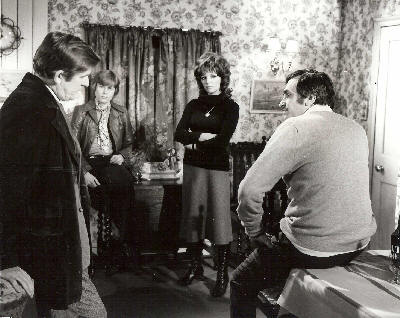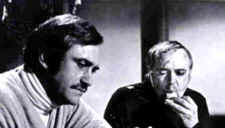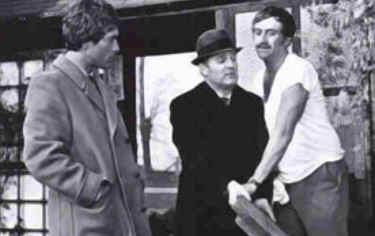

Revenge (1971)
James
Booth and Joan Collins star as parents who seek to avenge their molested
daughter's death when her probable killer goes free on a technicality.
With the help of Booth's college-aged son (from a previous marriage) and a
similarly-bereaved family friend, Booth sets out to kidnap the man they all
believe to be guilty (Kenneth Griffith). At first, everything goes
wrong: a vicious dog appears from nowhere and harasses everyone in sight,
while Booth discovers the getaway car won't start. But
eventually Booth and his accomplices successfully capture Griffith and take him
to the basement of the pub where Booth and Collins live. There Booth and
his friend work him over. When Collins enters the basement and sees her
daughter's murderer, she, too, attacks him. Then Booth goes too far and
kills Griffith, which causes everybody to go upstairs and worry.
But
surprise! Griffith isn't dead after all and his captors must decide
whether to murder him in cold blood or let him go free (and possibly report them
to the police). They decide to take him back to his own house and set up a
fatal gas explosion that will obliterate all traces of their involvement. (Like
every movie psycho since Norman Bates, Griffith lives in a big old house that's a
shrine to his dead mother.) But police arrive at Griffith's house and
scare the conspirators away before they can do anything.
Convinced
they'll all be caught, Booth sits at home getting plastered. (His
skillfully underplayed drunkenness is the highlight of this performance.)
Later that night, as Collins lies in bed beside her passed-out husband, she
makes a sexual overture but he's sound asleep and oblivious.
Meanwhile,
the son and his girlfriend are making out on the sofa downstairs. The
girlfriend, ignorant of the kidnapping, wants to go all the way but the
preoccupied son can't perform. They quarrel and the girlfriend leaves in a
huff.
Drawn by their angry voices, Collins comes
downstairs to soothe her step-son but he's in no mood for platitudes. He
storms into the basement to terrorize the bound, gagged captive by smashing
whisky bottles on the wall behind him. When Collins tries to intercede,
the son grabs Collins, tears off her negligee, and screams to Griffith, “This is
what a grown woman looks like. Isn't she beautiful?" Then he throws
his step-mother to the floor and climbs on top of
her. "No, please!" she cries. We
see this rape (or whatever it is--Collins stops her ineffectual struggles
pretty quickly) through the fractured eyeglasses of the sex criminal, who
keeps turning delicately away.
Next
morning Booth's daughter enters the basement to check on the captive, who still
can't get over the spectacle he witnessed the previous night. "I saw
them! I saw them! Right there!" he cries, outraged. (He may be
a child molester and murderer, but this...this offends even him.)
Collins's discarded panties, lying on the floor, confirm his story.
Rushing
back upstairs and waving the panties at her father, the distraught daughter sets
off a series of confrontations. Booth goes berserk and physically
attacks his wife and son. Collins brains him with a bottle,
knocking him unconscious, and frees the prisoner in the basement. When
Booth awakens from the blow, his wife
and son pack up their things and run off together.

As if he didn't have enough problems, Booth sees a newspaper story about some new evidence which makes him think his captive may have been innocent after all (surprise!). Griffith returns to the basement to find his glasses and remorseful Booth feeds, bathes, and clothes him in hope of winning his forgiveness and preventing prosecution for kidnapping.

But guess what. There's another plot twist. (Surprise!) Not to spoil the ending, let's just call it one more mechanical zig-zag in this strip of bloody rick-rack.
Revenge
is a strange movie. It deals with serious issues--child molestation,
grief, the logistical and emotional complications of revenge. But it's all
in such over-the-top bad taste that the seriousness can't be taken
seriously. A rich, gooey fudgecake of sensationalism and melodrama,
Revenge is the movie equivalent of the tumescent, overheated artwork on the
covers of raunchy old paperbacks like Sintime and The Wife-Swappers.
In
marvelous high-camp fashion, Revenge takes itself
seriously enough to attempt some arty touches, like three separate uses of
the "subjective camera." When Booth awakens from the
bottle blow, we experience his blurred vision. When Collins and her
stepson are rutting on the basement floor, we observe them through Griffith's
fractured eyeglasses. When Booth beats up Griffith in the basement, we
see his approaching fist through Griffith's eyes. But most of the time Revenge
is done in a serviceable, straightforward way that offers no distraction from
the film's basic flaws: improbable
action, stilted dialogue, and a story cluttered with reversals but still somehow
lacking in development.
Decent music would have helped this movie a lot. The tinny, simpleminded soundtrack casts a cheesy pall over every scene it accompanies.
Revenge has a multitude of wordy alternative titles: Revenge after Jenny Died, Behind the Cellar Door, and Terror from Under the House. When released in the US in 1976, Revenge became Inn of the Frightened People.

Appendix
Terrence Pettigrew, writing in British Film Character Actors (Totwa, N.J.: Barnes & Noble Books, 1982) gives high praise to Kenneth Griffith's performance in Revenge.
Films and Filming, May 1971 (Vol 17, No. 8) – .
Photospread on Revenge has two sides containing 6 pictures and no
review.